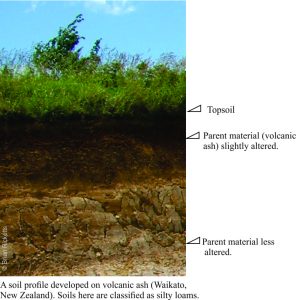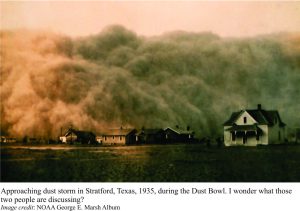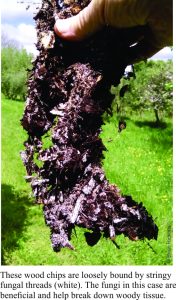The media loves hyperbole. In some ways they remind me of ‘The end is nigh’ cartoon guy. This week (Oct 16, 2017) it’s ‘Ecological Armageddon’, a kind of end-of-the-world announcement that is founded on what looks like a drastic reduction in the insect biomass in parts of Germany; 75% of insects have disappeared since 1989. I don’t mean to trivialise these alarming reports, because if it turns out to be a phenomenon of more global extent (the collapse of bee colonies does not augur well), then the ramifications for activities like food production could be dire. The report’s authors note that the cause of this reduction is not yet understood, a sensible comment based on the limited scope of their study (the paper is Open Access). But their caution has not stifled speculation and hyperbole.
The demise of insects segues into the topic of this blog; the alarming rate at which soils, globally, are being degraded. There is a symbiotic relationship between soils and insects, linked primarily to the vital role both play in vegetation productivity.
Soils, from which much of humanity’s food is derived, take 100s, if not 1000s of years to form. They are worlds unto themselves; they have physical and chemical form, support countless numbers of micro-organisms, larger critters like worms, beetles, and nematodes, and vegetation. And yet all of this can be seriously damaged in minutes with a spade. Collectively, we have degraded, if not destroyed, almost 40% of the soils used for agriculture; soils that have been seriously degraded have lost most of their topsoil – the part that matters. On a global scale, loss of soils is huge (in particular the topsoil)– it has been estimated that between 1950 to 2(000, losses amounted to 760 million tons a year. The rate of soil loss, and the decline in soil productivity is a bit like population growth, except it is going in the wrong direction.
What is a soil? We often think of soils as an inert collection of minerals, clays, and organic matter that provide a convenient home for worms. But soils are also alive! They form on materials ranging from hard rock to loose sediment (including volcanic ash). The parent materials (the original rock or sediment) are gradually broken down by the natural elements (wind, rain, freeze and thaw), by (slow) chemical reactions between slightly acidic rainwater and minerals, and importantly, micro- and macro-organisms. These processes tend to act faster in warm, humid climates. Coincidentally, vegetation is established, adding organic matter to the mix.
Soil scientists get quite carried away with their detailed descriptions, but it is easiest to think of soils as having two main components:
- Parent material consisting of broken down and altered minerals and clays; these are the primary sources of nutrients like potassium (K), phosphorous (P), calcium (Ca), magnesium (Mg), as well as important trace elements like zinc (Zn) and selenium (Se). The kind of parent material is a strong determinant of soil type; soils developed on limestone tend to be alkaline, those on basalts are commonly clay-rich (because of the chemical transformation of feldspars), whereas volcanic ash produces silty and sandy loams.
- The overlying organic layer, or topsoil contains dead and composted vegetation, organic matter like humus, a teeming population of micro-organisms (such as bacteria and fungi), and larger critters. Micro-organisms are absolutely critical to soil health and fertility – nearly all nutrients supplied to plants are mediated in some way by bacteria and fungi. The breakdown of dead plants to carbon and other nutrients is also strongly influenced by the microbiota. Topsoil thickness depends mainly on organic productivity and preservation, that in turn are functions of climate, topography, landscapes and, as it turns out, human intervention.
How are soils degraded?
Erosion by wind and surface-water runoff can occur naturally, but most soil loss results from poor land use. Deforestation, particularly in humid climates, immediately exposes soils to rain and surface runoff. Tillage is a common agricultural practice intended to rejuvenate topsoils, but this too can lead to serious depletion during surface-water runoff. Exposed soils are also prone to wind erosion, which removes fine particles that carry adsorbed nutrients. I’ve seen many a newly ploughed field shrouded in clouds of dust – there go the nutrients! The Dust Bowl, that hit the American Midwest in the 1930s, is a classic example of disastrous changes in land use (conversion from prairies to wheat fields) that resulted in soil loss (and livelihoods) over 1000s of square kilometres.
Loss of soil microbiota and biota biodiversity result from changes in land use (such as land-clearing and burning, changes in cropping or grazing, and intensification of farming) where the original organisms are out of sync with the new conditions of exposure or vegetation. Herbicides, fungicides, and insecticides also have a profound negative effect on the vitality of soil biota. Fertilizers too can change soil chemistry, especially pH, as well as the microbiota. Globally, use of fertilizers has increased more than 10-fold since 1950. The bottom line here is that, if soil microbes are not happy, then the appropriate nutrients will not be delivered to plants, and dead vegetation will not be converted to useful organic carbon.
Loss of organic carbon is a major problem in overworked soils, and stems primarily from inappropriate land management. Crops require carbon to grow (cells cannot develop without it). But crops are generally removed from the soil, which means that part of the carbon supply is also removed. Addition of fertilizers can replace lost nutrients like N, P, and K, but the organic carbon is rarely replaced. Over time, soils can become so depleted in organic carbon to render them quite useless. Organic carbon in bare and tilled soil is also exposed to air where it oxidizes to CO2. Burning during land clearing exacerbates this process.
Dry, semi-arid regions that have been converted for use in agriculture or horticulture, usually require irrigation. Irrigation in these conditions commonly results in salinization of soils. All natural fresh waters contain small amounts of dissolved minerals, or salts, that remain in the soil when the water evaporates. In humid regions, these salts are flushed out, but in dry conditions the salts gradually increase to the point where the soils can longer support crops. Irrigated soils in the US Southwest, Pakistan, India, Australia and Spain are particularly prone to salinization. The losses in crop production in these regions are counted in billions of dollars.
There is growing recognition that soil conservation is a prerequisite to the kind of food production needed for a burgeoning global population. Reduced soil productivity is a problem we are inflicting on ourselves. Part of the problem, particularly in agriculture, is that conservation efforts are often pitted against entrenched land-use practices (“this is the way we’ve always done it!” attitude). This applies not just to soils, but to water quality and supply, and all those disappearing insects. Good science will help to solve these problems, so long as land-users, politicians, and corporate folk are willing to listen.



















